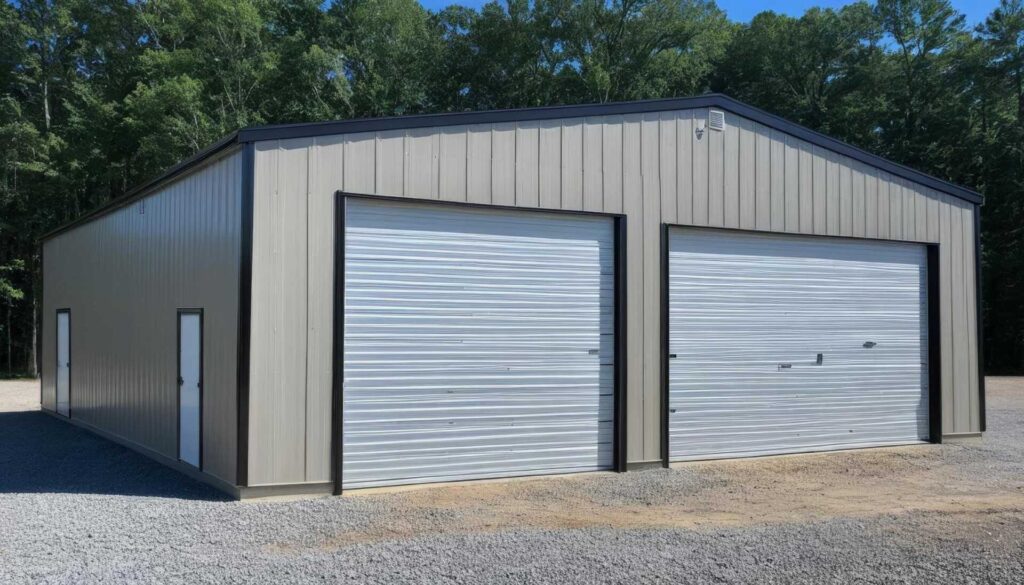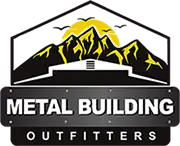
Contents
Imagine you’ve just moved into a new home, and you need a garage that fits your vehicles and provides extra storage, but you’re unsure where to start. When choosing a residential metal garage, several factors can impact your decision, from budget and design to materials and local regulations. Each choice you make can greatly affect functionality and durability. So, what are the key aspects you should consider to ensure you make an informed decision?
Key Takeaways
- Assess your available land area and ensure the garage’s dimensions meet your current and future needs for vehicles and storage.
- Evaluate your budget, considering construction costs, long-term maintenance, and potential enhancements.
- Check local building codes and zoning regulations to ensure compliance with size, height, and material requirements.
- Choose high-quality materials with good corrosion resistance, as this will enhance durability and reduce maintenance costs over time.
- Consider customization options for features like shelving and workbenches, which can improve organization and functionality in your garage.
Assess Your Space Requirements
When choosing a residential metal garage, evaluating your space requirements is essential. Start by measuring your available land area. Consider the space dimensions of the garage itself and how it fits into your overall property. You want to ensure that there’s enough room for both the garage and any additional features you might want, like driveways or landscaping.
Next, think about the garage layout. Will you need room for vehicles, storage, a workshop, or even recreational equipment? If you’ve got multiple vehicles or plan to use the garage for hobbies, opting for a larger size will serve you better in the long run.
Make a list of everything you want to store or work on within the garage to help you visualize the space.
Also, consider accessibility. You’ll want to factor in how easily you can enter and exit the garage, both for vehicles and for yourself. Think about the flow of movement; a well-planned layout can save time and hassle.
Lastly, don’t forget about zoning regulations and neighborhood aesthetics. You want your garage to be functional and harmonize with your home and surroundings.
Determine Your Budget
Before you start shopping for a metal garage, it’s essential to assess your financial limits.
Remember to factor in additional costs like permits, site preparation, and any future maintenance.
Having a clear budget will help you make informed decisions and avoid overspending.
Assess Your Financial Limits
Many homeowners underestimate the importance of setting a realistic budget when choosing residential metal garages. Proper financial planning is essential to avoid overspending and ensure you get the best value for your investment.
Start by conducting a cost analysis to understand the various factors that contribute to the total price, including the size, materials, and features of the garage.
Next, consider your financial limits. Determine how much you can comfortably allocate without straining your budget. This involves reviewing your savings, potential financing options, and any other expenses you might have.
Remember, it’s easy to get swept up in the excitement of selecting a garage, but sticking to your financial limits keeps you grounded and focused on what you truly need.
Also, think about what you can afford not just in the short term, but over the lifespan of the garage. Factor in maintenance, insurance, and potential upgrades.
Factor In Additional Costs
Budgeting for a residential metal garage involves more than just the initial purchase price; it’s crucial to factor in additional costs that can arise during and after installation.
First, consider installation costs, which can vary based on the size and complexity of your garage. Hiring professionals might be a necessity, and their fees will notably impact your overall budget.
Next, don’t overlook maintenance expenses. While metal garages generally require less upkeep than traditional structures, they aren’t maintenance-free. Over time, you’ll need to budget for rust prevention, paint touch-ups, or repairs due to wear and tear.
Additionally, think about any necessary permits or site preparation work. If your property needs grading or a concrete slab, those costs can add up.
You may also want to include expenses for insulation, electrical work, or shelving, which can enhance functionality but will increase your total investment.
Choose the Right Design
When choosing the right design for your metal garage, start by considering your specific needs and how you’ll use the space.
Think about the aesthetic you want to achieve, as well as the functionality required for storage or projects.
Don’t forget to check local building codes to ensure your design meets all regulations.
Consider Your Needs
Before diving into the details of purchasing a residential metal garage, it’s important to assess your specific needs. Understanding the purpose of your garage will help you make informed decisions that best suit your lifestyle.
Whether it’s for vehicle storage or other uses, knowing what you want will guide your choices.
Consider these key factors:
Garage Purpose: Will it primarily serve as a space for vehicle storage, or do you need additional room for hobbies or storage?
Size Requirements: How many vehicles do you own, and what are their dimensions? Factor in space for movement and maintenance.
Future Needs: Do you plan to expand your vehicle collection or require extra storage in the future? Anticipating growth can save you from future headaches.
Accessibility: How often will you be using the garage? Make sure it’s conveniently located and designed for easy access.
Aesthetic and Functionality
Once you’ve identified your needs, it’s time to think about the aesthetic and functionality of your metal garage. The right design can enhance your home’s appearance while providing the practical features you require.
Start by considering the overall aesthetic appeal you want to achieve. Do you prefer a modern look, or are you more inclined toward a traditional style? The color and finish of your metal garage can greatly influence its visual impact, so choose options that complement your home.
Next, focus on functional design. Think about how you’ll use the space and what features will make it more efficient. For instance, if you plan to store vehicles, ascertain the dimensions to accommodate them comfortably. If you need extra storage or a workspace, consider designs that include shelving or workbenches.
Lastly, aim for a balance between aesthetic appeal and functionality. A garage that looks good but lacks practicality won’t serve you well in the long run.
Local Building Codes
Understanding local building codes is essential for choosing the right design for your metal garage. By familiarizing yourself with these regulations, you’ll ensure compliance and enhance your garage’s functionality and safety.
Here are key factors to take into account:
Zoning Regulations: Check your area’s zoning regulations, as they dictate where you can place your garage on your property. Understanding setbacks and lot coverage will help you avoid costly mistakes.
Permit Requirements: Many municipalities require permits for new constructions. Make sure you know what’s necessary to obtain these permits—failing to do so could lead to fines or forced removal.
Height Restrictions: Some locations have specific height restrictions for structures. Knowing these limits will help you design a garage that fits within legal parameters.
Materials Standards: Local building codes may dictate which materials are acceptable for construction. Ensure your metal garage uses compliant materials to maintain durability and safety.
Consider Local Building Codes
When planning to install a residential metal garage, it’s vital to check your local building codes. These codes can vary considerably depending on your location, and understanding them is important for a smooth installation process.
Start by looking into zoning regulations that govern the use of your property. These regulations dictate where you can place your garage and how large it can be. You don’t want to invest time and money only to find out later that your garage doesn’t comply with local requirements.
Next, familiarize yourself with the permit requirements for your area. Most municipalities require homeowners to obtain a permit before constructing any major structure, including metal garages. The application process might involve submitting plans and possibly even undergoing inspections. By obtaining the necessary permits, you protect yourself from potential fines or the need to remove the garage later.
Additionally, checking local building codes ensures your garage is built to withstand environmental factors specific to your region, such as snow loads or wind resistance. This knowledge helps in compliance and assures the safety and durability of your investment.
Evaluate Material Quality
After ensuring compliance with local building codes, the next step is to evaluate the material quality of your metal garage. Choosing the right materials is essential for ensuring longevity and performance. You want a garage that looks good and stands the test of time.
Focusing on material durability and corrosion resistance will help you make a sound investment.
Consider these key factors:
Steel Gauge: The thickness of the steel affects its strength. Opt for heavier gauge steel, as it offers better durability and resistance against impacts.
Coating: Look for galvanized or baked enamel finishes. These coatings enhance corrosion resistance, protecting your garage from rust and weather damage over time.
Warranties: A solid warranty can indicate how confident the manufacturer is in their product’s durability. Seek warranties that cover both material and craftsmanship.
Environmental Adaptability: Consider the climate in your area. Some materials perform better in extreme temperatures or humidity, affecting their durability and resistance to corrosion.
Explore Customization Options
Customizing your metal garage can transform it into a functional and visually appealing space tailored to your needs. By exploring various custom features and color options, you can create a garage that reflects your personality while serving practical purposes.
Start by considering the layout and dimensions that suit your lifestyle. Do you need extra storage space or perhaps a workshop area? Custom features like shelving, workbenches, or garage doors can enhance accessibility and organization.
Next, think about aesthetics. The color options available for your garage can greatly impact its overall look. Choose a palette that complements your home and neighborhood. You might consider a bold color for a modern vibe or more muted tones for a classic appearance.
Here’s a simple comparison table to help guide your choices:
| Custom Features | Color Options |
|---|---|
| Workbenches | Classic White |
| Shelving Units | Earthy Green |
| Insulated Doors | Rustic Red |
| Windows for Natural Light | Sleek Gray |
Plan for Future Needs
Often, planning for future needs is crucial when choosing a metal garage, as it helps you avoid costly modifications down the line. By anticipating your future expansion requirements, you can make a long-term investment that serves your family’s needs for years to come.
Here are some key factors to take into account:
Size: Think about the space you currently need and how it might increase. Will you want to park additional vehicles or store equipment in the future?
Functionality: Reflect on how your garage might serve multiple purposes. Will it need to accommodate a workshop or even a gathering space for family events?
Accessibility: Verify that your garage is designed to allow easy access for larger vehicles or equipment. This foresight can save you headaches later on.
Zoning Regulations: Check local regulations for future expansions. Understanding these rules now will save you from potential legal issues when you decide to expand later.
Recap
In the grand quest for the perfect metal garage, don’t just settle for a glorified tin can that looks like it was plucked from a junkyard. Instead, envision a fortress for your vehicles, one that’s both stylish and functional. By following these tips, you’ll dodge the pitfalls of poor planning and questionable materials, ensuring your garage isn’t the neighborhood’s eyesore but rather a shining example of smart investment. After all, your car deserves a palace, not a metal shed.
Recent Posts
Maximize Longevity With Metal Garage Solutions
When you consider investing in a metal garage, metal solutions offer a remarkable blend of
What Are the Benefits of Tailored Metal Structures?
Imagine a well-crafted suit tailored to fit perfectly; that’s how tailored metal structures operate in
3 Tips for Long-lasting Metal Commercial Structures
When it comes to metal commercial structures, you’ll want to focus on a few key




